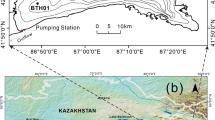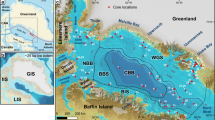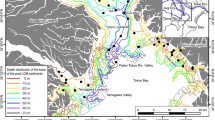Abstract
The new BDP-98 drill core of the Baikal Drilling Project is a key palaeoclimate record in continental Asia because globally sensitive sedimentary records of such length and continuity are very rare1,2,3. Kashiwaya et al.4 have attempted signal processing of the BDP-98 average grain-size record, but in constructing their age model they excised a 100-metre interval from the 600-metre section, stating that it is “erroneous”4. On the basis of our lithological studies, we consider that this excision is unjustified.
Similar content being viewed by others
Main
Moreover, the interval excised by Kashiwaya et al.4 corresponds to the spatially continuous sedimentary unit between seismic reflection boundaries B7 and B8 at Academician Ridge, Lake Baikal2,5. In addition, the lithology of the BDP-98 section reflects a progressive change of facies from shallow-water pro-deltaic to deep-water hemipelagic sedimentation at the drill site (Fig. 1). These findings imply that the sedimentation rates in the lower part of the BDP-98 are significantly higher than those assumed by Kashiwaya et al.4 and that the bottom age of the BDP-98 is significantly younger, perhaps around 9–10 Myr (ref. 2).
The lithology of the section also shows that there is no justification for the excision of the shaded interval in order to fit the age model. All of the components, apart from diatom abundance and sand laminae, are expressed as occurrences per 1-m interval in the split core3.
We agree that the long-term insolation cycles are imprinted in the Lake Baikal palaeoclimate proxy records3, but our lithological results indicate that there is a need to revise the age model and the signal- processing results of Kashiwaya et al.4.
References
BDP Members,. Russian Geol. Geophys. 41, 3–32 (2000).
Antipin, V. et al. Quat. Int. 80–81, 19–36 (2001).
Williams, D. F. et al. Science 278, 1114–1117 (1997).
Kashiwaya, K., Ochial, S., Sakai, H. & Kawai, T. Nature 410, 71–74 (2001).
Moore, T. C., Klitgord, K. D., Golmstok, A. J. & Weber, E. GSA Bull. 109, 746–766 (1997).
Author information
Authors and Affiliations
Corresponding author
Rights and permissions
About this article
Cite this article
Prokopenko, A., Karabanov, E. & Williams, D. Age of long sediment cores from Lake Baikal. Nature 415, 976 (2002). https://doi.org/10.1038/415976a
Issue Date:
DOI: https://doi.org/10.1038/415976a
This article is cited by
-
A late Cenozoic Earth's crust and climate dynamics record from Lake Baikal
Journal of Paleolimnology (2004)
Comments
By submitting a comment you agree to abide by our Terms and Community Guidelines. If you find something abusive or that does not comply with our terms or guidelines please flag it as inappropriate.




